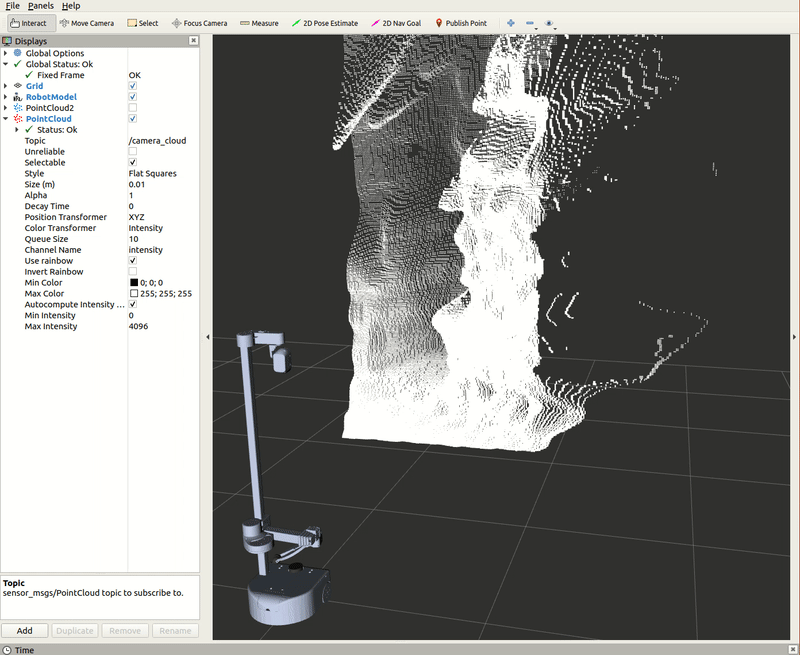PointCloud Transformation
Example 11
This tutorial highlights how to create a PointCloud message from the data of a PointCloud2 message type, then transform the PointCloud's reference link to a different frame. The data published by RealSense is referencing its camera_color_optical_frame link, and we will be changing its reference to the base_link.
Begin by starting up the stretch driver launch file.
roslaunch stretch_core stretch_driver.launch
roslaunch stretch_core d435i_low_resolution.launch
cd catkin_ws/src/stretch_tutorials/src/
python3 pointcloud_transformer.py
Within this tutorial package, there is an RViz config file with the PointCloud in the Display tree. You can visualize this topic and the robot model by running the command below in a new terminal.
rosrun rviz rviz -d /home/hello-robot/catkin_ws/src/stretch_tutorials/rviz/PointCloud_transformer_example.rviz
The GIF below visualizes what happens when running the previous node.

The Code
#!/usr/bin/env python3
import rospy
import tf
import sensor_msgs.point_cloud2 as pc2
from sensor_msgs.msg import PointCloud2, PointCloud
from geometry_msgs.msg import Point32
from std_msgs.msg import Header
class PointCloudTransformer:
"""
A class that takes in a PointCloud2 message and stores its points into a
PointCloud message. Then that PointCloud is transformed to reference the
'base_link' frame.
"""
def __init__(self):
"""
Function that initializes the subscriber, publisher, and other variables.
:param self: The self reference.
"""
self.pointcloud2_sub = rospy.Subscriber("/camera/depth/color/points", PointCloud2, self.callback_pcl2, queue_size=1)
self.pointcloud_pub = rospy.Publisher("/camera_cloud", PointCloud, queue_size=1)
self.pcl2_cloud = None
self.listener = tf.TransformListener(True, rospy.Duration(10.0))
rospy.loginfo('Publishing transformed PointCloud. Use RViz to visualize')
def callback_pcl2(self,msg):
"""
Callback function that stores the PointCloud2 message.
:param self: The self reference.
:param msg: The PointCloud2 message type.
"""
self.pcl2_cloud = msg
def pcl_transformer(self):
"""
A function that extracts the points from the stored PointCloud2 message
and appends those points to a PointCloud message. Then the function transforms
the PointCloud from its the header frame id, 'camera_color_optical_frame'
to the 'base_link' frame.
:param self: The self reference.
"""
temp_cloud = PointCloud()
temp_cloud.header = self.pcl2_cloud.header
for data in pc2.read_points(self.pcl2_cloud, skip_nans=True):
temp_cloud.points.append(Point32(data[0],data[1],data[2]))
transformed_cloud = self.transform_pointcloud(temp_cloud)
self.pointcloud_pub.publish(transformed_cloud)
def transform_pointcloud(self,msg):
"""
Function that stores the PointCloud2 message.
:param self: The self reference.
:param msg: The PointCloud message.
:returns new_cloud: The transformed PointCloud message.
"""
while not rospy.is_shutdown():
try:
new_cloud = self.listener.transformPointCloud("base_link" ,msg)
return new_cloud
if new_cloud:
break
except (tf.LookupException, tf.ConnectivityException,tf.ExtrapolationException):
pass
if __name__=="__main__":
rospy.init_node('pointcloud_transformer',anonymous=True)
PCT = PointCloudTransformer()
rate = rospy.Rate(1)
rospy.sleep(1)
while not rospy.is_shutdown():
PCT.pcl_transformer()
rate.sleep()
The Code Explained
Now let's break the code down.
#!/usr/bin/env python3
Every Python ROS Node will have this declaration at the top. The first line makes sure your script is executed as a Python3 script.
import rospy
import tf
import sensor_msgs.point_cloud2 as pc2
from sensor_msgs.msg import PointCloud2, PointCloud
from geometry_msgs.msg import Point32
from std_msgs.msg import Header
You need to import rospy if you are writing a ROS Node. Import tf to utilize the transformPointCloud function. Import various message types from sensor_msgs.
self.pointcloud2_sub = rospy.Subscriber("/camera/depth/color/points", PointCloud2, self.callback_pcl2, queue_size=1)
Set up a subscriber. We're going to subscribe to the topic /camera/depth/color/points, looking for PointCloud2 message. When a message comes in, ROS is going to pass it to the function callback_pcl2() automatically.
self.pointcloud_pub = rospy.Publisher("/camera_cloud", PointCloud, queue_size=1)
This section of code defines the talker's interface to the rest of ROS. self.pointcloud_pub = rospy.Publisher("/camera_cloud", PointCloud, queue_size=1) declares that your node is publishing to the /camera_cloud topic using the message type PointCloud.
self.pcl2_cloud = None
self.listener = tf.TransformListener(True, rospy.Duration(10.0))
The first line of code initializes self.pcl2_cloud to store the PointCloud2 message. The second line creates a tf.TransformListener object. Once the listener is created, it starts receiving tf transformations and buffers them for up to 10 seconds.
def callback_pcl2(self,msg):
"""
Callback function that stores the PointCloud2 message.
:param self: The self reference.
:param msg: The PointCloud2 message type.
"""
self.pcl2_cloud = msg
The callback function then stores the PointCloud2 message.
temp_cloud = PointCloud()
temp_cloud.header = self.pcl2_cloud.header
Create a PointCloud for temporary use. Set the temporary PointCloud header to the stored PointCloud2 header.
for data in pc2.read_points(self.pcl2_cloud, skip_nans=True):
temp_cloud.points.append(Point32(data[0],data[1],data[2]))
Use a for loop to extract PointCloud2 data into a list of x, y, and z points and append those values to the PointCloud message, temp_cloud.
transformed_cloud = self.transform_pointcloud(temp_cloud)
Utilize the transform_pointcloud function to transform the points in the PointCloud message to reference the base_link
while not rospy.is_shutdown():
try:
new_cloud = self.listener.transformPointCloud("base_link" ,msg)
return new_cloud
if new_cloud:
break
except (tf.LookupException, tf.ConnectivityException,tf.ExtrapolationException):
pass
Try to look up and transform the PointCloud input. Use a try-except block, since it may fail on any single call, due to internal timing issues in the transform publishers. Transform the point cloud data from camera_color_optical_frame to base_link with the transformPointCloud() function.
self.pointcloud_pub.publish(transformed_cloud)
Publish the new transformed PointCloud.
rospy.init_node('pointcloud_transformer',anonymous=True)
PCT = PointCloudTransformer()
The next line, rospy.init_node(NAME, ...), is very important as it tells rospy the name of your node -- until rospy has this information, it cannot start communicating with the ROS Master.
Note
The name must be a base name, i.e. it cannot contain any slashes "/".
Declare a PointCloudTransformer object.
rate = rospy.Rate(1)
rospy.sleep(1)
The first line gives the listener some time to accumulate transforms. The second line is the rate at which the node is going to publish information (1 Hz).
while not rospy.is_shutdown():
PCT.pcl_transformer()
rate.sleep()
Run a while loop until the node is shut down. Within the while loop run the pcl_transformer() method.